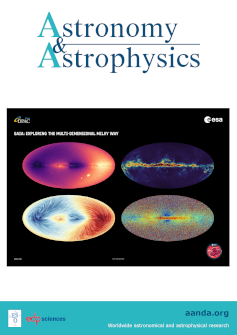The effects of the orbital configurations of mergers on reshaping galaxy structures
IF 5.8
2区 物理与天体物理
Q1 ASTRONOMY & ASTROPHYSICS
引用次数: 0
Abstract
We performed a systematic analysis of how the orbital configuration of a merger can influence the structural formation of remnant galaxies using 531 merger pairs selected from IllustrisTNG-100. We comprehensively described the merger orbital configuration, considering the relative orbital motion of the merger pair and their disk orientations. We quantified the galaxy structures by dynamically defining four components: bulge, disk, warm component, and hot inner stellar halo. For mergers on spiral-in orbits, the disk planes of the two merging galaxies tend to be aligned with the orbital plane, leading to higher fractions for the disk and warm components, as well as lower fractions for the bulge and hot inner stellar halo components in the remnant galaxy. For mergers on direct collision orbits, the disk planes of the two galaxies tend to be perpendicular to the orbital plane, leading to lower fractions for disk and warm components, as well as higher fractions of the bulge and hot inner stellar halo in the remnant. Mergers can lead to either an increase or decrease in the disk and bulge mass fraction in the remnant compared to the progenitor galaxy, depending on the merger orbital configurations; however, in 93% of cases, mergers cause an increase in the hot inner stellar halo. As a result, the luminosity fraction of the hot inner stellar halo (but not the bulge) in galaxies at z = 0 is highly correlated with its total ex situ stellar mass. In addition, we find that merger on spiral-in orbits is one of the possible reasons for the formation of recently discovered red but H I-rich (RR) galaxies.合并轨道构型对星系结构重塑的影响
我们使用从IllustrisTNG-100中选择的531对合并对,系统地分析了合并的轨道配置如何影响残余星系的结构形成。我们综合描述了合并轨道构型,考虑了合并对的相对轨道运动和它们的盘取向。我们通过动态定义四种成分来量化星系结构:凸起、盘状、温暖成分和炽热的内星晕。对于螺旋轨道上的合并,两个合并星系的盘面倾向于与轨道平面对齐,导致盘和温暖成分的分数较高,而残余星系中凸起和热的内恒星晕成分的分数较低。对于直接碰撞轨道上的合并,两个星系的盘面倾向于垂直于轨道平面,导致盘和热成分的比例较低,而残余中的凸起和热内星晕的比例较高。与原星系相比,合并可能导致残余星系中盘状和凸起质量分数的增加或减少,这取决于合并轨道的配置;然而,在93%的情况下,合并会导致恒星内部热晕的增加。因此,在z = 0的星系中,热内星晕(但不是凸起)的光度分数与它的总离地恒星质量高度相关。此外,我们发现螺旋轨道上的合并是最近发现的红色但富含H (RR)星系形成的可能原因之一。
本文章由计算机程序翻译,如有差异,请以英文原文为准。
求助全文
约1分钟内获得全文
求助全文
来源期刊

Astronomy & Astrophysics
地学天文-天文与天体物理
CiteScore
10.20
自引率
27.70%
发文量
2105
审稿时长
1-2 weeks
期刊介绍:
Astronomy & Astrophysics is an international Journal that publishes papers on all aspects of astronomy and astrophysics (theoretical, observational, and instrumental) independently of the techniques used to obtain the results.
 求助内容:
求助内容: 应助结果提醒方式:
应助结果提醒方式:


